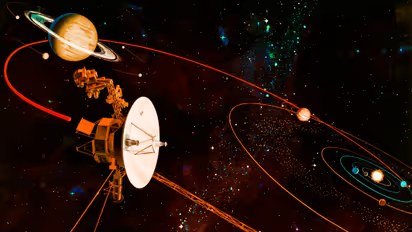Climate change: Space junk burning may punch holes in ozone layer

Synopsis
A new study warns that burning up thousands of old satellites yearly could release aluminium and other metals into the upper atmosphere, risking ozone damage, climate disruptions, and hindering global efforts to protect Earth’s environment.
Right now, more than 9,000 satellites orbit the Earth, quietly powering everything from weather forecasts and phone calls to GPS navigation and Earth monitoring. But what happens to these satellites when they reach the end of their life?
Typically, old satellites are pushed into lower orbits and allowed to fall back to Earth, where they burn up in the atmosphere. This process has been considered routine and harmless for decades. However, a new scientific study warns that this might not be so safe for the planet after all — especially for the climate.
Published in the Journal of Geophysical Research: Atmospheres, the study says that by 2040, more than 60,000 satellites could be circling Earth — nearly seven times the number today. If around 3,000 of these are decommissioned and burned up each year, the upper atmosphere could be exposed to nearly 10,000 tonnes of aluminium oxide annually, the researchers estimate.
Aluminium oxide is a byproduct of burning satellite material, especially the metal casings. When released high above the Earth, this substance doesn't behave like ordinary ground-level pollutants. Instead, it accumulates in the mesosphere and lower thermosphere — the upper layers of the atmosphere — particularly around the polar regions. This accumulation, scientists warn, could cause localized temperature increases of up to 1.5°C, slow down wind patterns, and even damage the already fragile ozone layer.
The ozone layer, which sits in the stratosphere, shields life on Earth from harmful ultraviolet (UV) radiation. It has been slowly recovering over the past decades thanks to global action, such as the Montreal Protocol which phased out ozone-depleting substances like CFCs. But the introduction of metal particles like aluminium oxide from satellite re-entry could interfere with this progress. The study suggests that these particles may trigger chemical reactions that destroy ozone molecules, making the recovery of the ozone hole in polar regions more difficult.
And it’s not just aluminium. Other metals such as titanium, copper, lithium, and iron are also expected to enter the atmosphere during satellite burn-up. Their long-term impact hasn’t yet been studied in detail, but scientists fear these materials could bring additional risks.
To make things worse, these emissions occur high above the surface, where weather and natural processes are slower at cleaning up pollutants. Once these particles settle into the upper atmosphere, they could linger for years, changing temperature balances and wind dynamics, and ultimately affecting how heat is distributed globally.
Climate impacts beyond the atmosphere
The potential fallout isn't limited to the skies. Changes in the upper atmosphere can eventually cascade downward, subtly altering weather patterns, jet streams, and even rainfall. In a world already struggling with rising temperatures, disappearing ice caps, and erratic weather, this added disruption from space debris may complicate climate modelling and planning.
Experts say the time to act is now. Solutions may include designing satellites with cleaner materials, better end-of-life disposal strategies, or moving toward “space sustainability” practices that reduce atmospheric pollution from above. As the satellite industry booms — especially with mega-constellations from companies like SpaceX, Amazon, and others — the environmental cost of space activity can no longer be ignored.